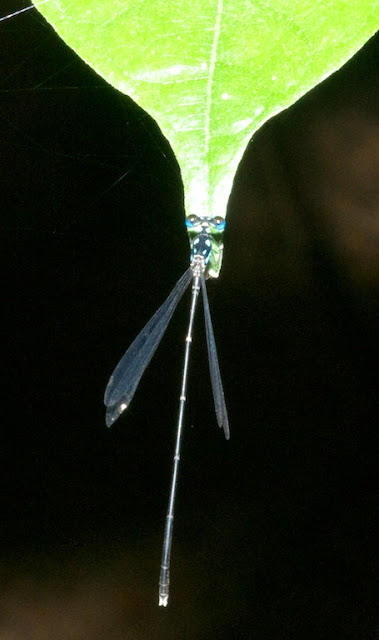This writeup conflates two mornings at Bukit Gasing, on August 30 and September 7, 2014.
Chips and Shirley follow a well-used hiking loop, and Eileen goes with them, but I linger along the stream on the first part of the trail. It's a lot less work, and there is plenty to keep me occupied as I work my way back and forth.
There are, of course, attractive streamside plants for me to photograph, if not actually identify (though this appears to be the young leaf of a sort of fern).
The parallel main veins and ladder-like crossbars on the leaves of this plant suggest that this is some sort of melastome.
I have no idea what this plant, with its curiously-misshapen flowers, might be, but I would love to know. Can any of my readers enlighten me?
This one I can identify: a spikemoss (Selaginella), a non-flowering plant that forms a common ground cover on them loot of tropical forests around the world. Spikemosses are not mosses, but true vascular plants related to the equally-misnamed clubmosses (Lycopodiales).
Fungi provide photographic distractions of their own, whether they are bracket fungi...
... or mushrooms of various sorts.
These delicate little parasols may be a species of Omphalina or one of its relatives. Omphalinoids, as they are called, are agaric mushrooms, and are not edible.
I have made considerable efforts to try to find out what this streamside frog is, but without success. Once again, can one of my readers help me?
My chief objects of interest, as I worked my way back and forth along the edge of the stream, were two species of tiny damselfly - a fact that any of my long-term readers should fail to find surprising. Both are members of the Old-World tropical family Platycnemididae.
Coeliccia albicauda is a species I have featured here before (on my last writeup on a trip to Bukit Gasing, when the damselflies were memorably upstaged by a migrant Hooded Pitta) is the more delicate of the two. I usually found it clinging to a leaf tip; if you are at all familiar with spikemosses, the Selaginella frond in the lower photograph should give you an idea of how tiny this insect is.
Notice the conspicuously white genitalia; 'albicauda' means 'white-tailed'. The species ranges from Thailand to Singapore, where it is known as the White-tailed Sylvan.
Copera marginipes is known in Singapore as the Yellow Featherlegs, a reference to the feathery bristles on its legs that it uses as an insect trap. This is one of a number of damselflies, from different families, that use coloured legs as a display feature.
It, too, boasts white genitalia. As with many other damselflies, light or bright colours on the last abdominal segments can stand out like a heliograph even when the rest of the insect is almost invisible. Is this a display for other damselflies, a distraction for predators, or both?
A newly-emerged, or teneral, Copera marginipes raises no such issues. This so-called "ghost" phase (I do not know how long it lasts) makes this look like a totally different damselfly (also, this appears to be a female). I kept looking for damselflies that actually were different along the stream, but in the stretch I covered these two species seemed to have the place to themselves.
































No comments:
Post a Comment